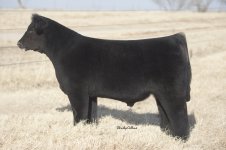simba
Well-known member
I'm not trying to start an argument, I'm just really curious: Why is everyone (and by everyone I mean most people) in the club calf industry so infatuated with big boned cattle? I come from a Hereford background and I don't think I've ever heard a judge in a Hereford or multi breed class say that an animal lost a class or was placed down because they needed more bone. I agree that an animal needs to be able to carry themselves, I've just noticed that on a lot of pictures that people post on SP, many people say they would like to add more bone. Or people are looking for bulls that will add bone to their calves. I've always really liked those nice feminine females, but now many of the heifers that I see are bred for beautiful front ends, smooth shoulders and massive legs. In my opinion although they are great animals, they look really unproportionate. Like I said, I'm not trying to start an argument or point fingers, I'm just wondering: Why more bone?

